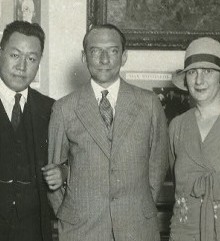|
F. Ray Comstock
F. Ray Comstock (27 August 1878 – 15 October 1949) was an American theatrical producer and theater operator. He pioneered the intimate musical comedy, staging several successful comedies at his Princess Theatre in Manhattan. He also produced spectacular musicals, variety shows and serious plays by authors such as Henrik Ibsen and Maxim Gorky. Early yearsF. Ray Comstock was born in Buffalo, New York, on 27 August 1878.[1] His first job was as a theater usher in Buffalo. He moved to New York, and became assistant treasurer at the Criterion Theatre.[2] In 1905 he presented The School Girl, which ran for 150 nights at Daly's Theater. The original show ran for 400 nights at the Prince of Wales Theatre, London.[3] In 1905 Comstock held the lease at the Hippodrome Theatre. That year he entered into a partnership with Morris Gest.[4] Gest was of Russian Jewish origins, an immigrant to the USA.[5] In 1907 Comstock put on his first Broadway theatre production, Fascinating Flora. This was followed in 1908 by Bandana Land, one of the first “Negro” musicals.[2] In 1909 Comstock leased the Colonial Theater in Cleveland, Ohio. The next year he leased it to the Shubert brothers.[6] Princess Theatre musicals Archibald Selwyn partnered with the Shubert Brothers and William A. Brady in building the Princess Theatre, a small 299-seat auditorium on 39th street that opened in 1913. The theater was not successful at first, and Selwyn and Brady gave up their shares to Comstock.[7] Comstock produced Jerome Kern's Nobody Home in 1915, presented in the Princess Theatre. The reaction was generally favorable, and Comstock recognized that a small house like the Princess could provide a venue for a musical comedy that was more intimate and friendly than a larger theater.[8] Comstock formed the Marbury-Comstock Company with Elizabeth Marbury, and commissioned a second musical comedy from Kern, Very Good Eddie. This opened on 23 December 1915 and ran for 341 performances. It then went on the road for another year.[8] The show was deliberately informal and low key, with a more coherent story line than most such comedies and less dancing. It established the genre of the "intimate" musical comedy.[9] The Princess Theatre musicals revolved around modern people in situations that were comic but possible. A cast of about thirty was supported by an eleven-piece orchestra. There were two sets, both relatively simple.[10] This was a gamble, but it paid off.[11] Elliot and Comstock co-produced Oh, Boy!, which opened at the Princess on 20 February 1917. The show, by Kern, Guy Bolton and P. G. Wodehouse, starred the young Marion Davies, Justine Johnstone, Tom Powers and Edna May Oliver.[9] Oh, Boy! ran for 463 performances.[12] Oh, Lady! Lady!! was another successful musical by the same team.[2] It opened at the Princess on 1 February 1918 and ran for 219 performances. Stars included Vivienne Segal and Margaret Dale.[12] Film productionsComstock ventured into film. The F. Ray Comstock Film Corporation released Evidence in 1915, a silent film drama.[13] In 1916 the F. Ray Comstock Photoplay Company released The Lottery Man, a silent feature based on the play of the same name by Rida Johnson Young. Comstock co-produced the film with Leopold and Theodore Wharton. The film was made in 1915 at Wharton Studios in Ithaca, New York.[14] Other shows Leave It to Jane, co-produced with William Elliot, opened at the Longacre Theatre on 28 August 1917 and ran for 167 performances. This was another new musical with lyrics by P.G. Wodehouse. Miss 1917 opened at the Century Theatre on 5 November 1917. It only lasted 48 performances.[12] In 1917 Comstock and Morris Gest began rehearsals for a Broadway production of the hit British musical extravaganza Chu Chin Chow at the Manhattan Opera House. After several weeks of rehearsal, the cast still did not know when the show would open or what they would be paid. The Actors' Equity Association, had been formed in 1913 to arbitrate disputes over pay and working hours with the Managing Producer's Association. They saw Chu Chin Chow as an opportunity for a class action. Comstock moved quickly to agree on wages with the cast, and forestalled the threat.[15] Chu Chin Chow, staged by Gest, William Elliott and Comstock was a "musical tale of the East". The musical starred Tyrone Power, Sr., Florence Reed and George Rasely. It combined elements of pantomime, ballet, musical comedy and comic opera. The settings, lighting, music and stagecraft techniques combined to make a remarkable production.[16] On 31 December 1917 William Elliott, Comstock, and Gest announced that they had leased the Century Theatre and would transfer Chu Chin Chow there in January 1918. They subsequently used the Manhattan Opera House for melodramatic spectacles, while the Century would be devoted exclusively to "the highest class musical productions".[5] Comstock and Gest produced Aphrodite at the Century Theatre, running for 148 performances in 1919–20. An exotic musical spectacle with an Oriental theme, the show had no real substance.[17] In January 1922 Comstock and Gest announced that they had engaged the Chauve-Souris company from the Art Theatre, Moscow. This was a 35-person company directed by Nikita Balieff that performed one-act plays, comedies, tragedies, songs, dances and musical numbers.[18] Balieff was seen as a rebel, and was much praised in America.[19] F. Ray Comstock died in Boston, Massachusetts, on 15 October 1949.[20] ProductionsComstock's productions included:[20]
ReferencesCitations
Sources
External linksWikimedia Commons has media related to F. Ray Comstock. |
||||||||||||
